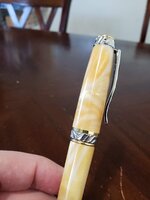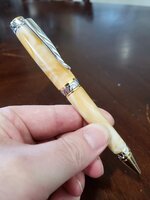RunnerVince
Member
Hi all,
I've been trying to up my acrylic game lately, and I'm just struggling. The biggest issue I'm getting is a "crackling" effect on the inside of the blank. I can't tell whether it's the blank itself, the adhesive, or the paint that's doing it, but I've gotten it on pens I've done with both epoxy and gorilla glue. It's driving me mad. I've tried acrylic paints, plain white spraypaint, and the high-temperature white spraypaint that @jttheclockman recommended, and I get the same issues with all three. In all cases, I've given the paint a minimum of 24 hours (up to a week or two) of time to dry. I wondered if it could be something with how I'm sanding, but those don't look like any scratch patterns I've ever seen.
See the picture below. Does anyone know what's causing this, and what I can do differently to avoid it?

I've been trying to up my acrylic game lately, and I'm just struggling. The biggest issue I'm getting is a "crackling" effect on the inside of the blank. I can't tell whether it's the blank itself, the adhesive, or the paint that's doing it, but I've gotten it on pens I've done with both epoxy and gorilla glue. It's driving me mad. I've tried acrylic paints, plain white spraypaint, and the high-temperature white spraypaint that @jttheclockman recommended, and I get the same issues with all three. In all cases, I've given the paint a minimum of 24 hours (up to a week or two) of time to dry. I wondered if it could be something with how I'm sanding, but those don't look like any scratch patterns I've ever seen.
See the picture below. Does anyone know what's causing this, and what I can do differently to avoid it?


